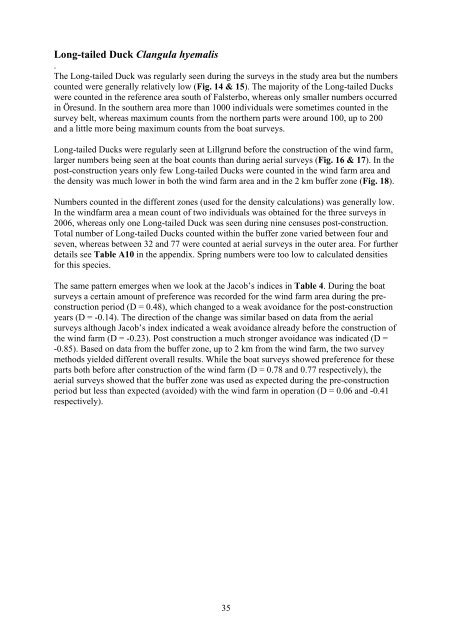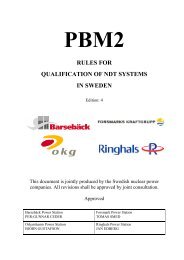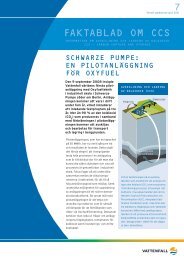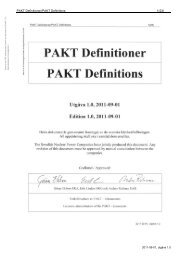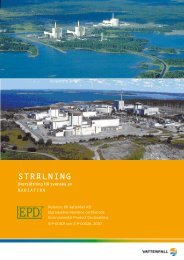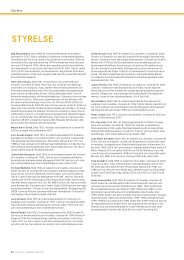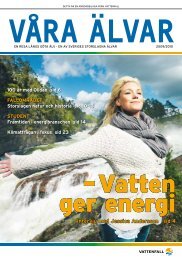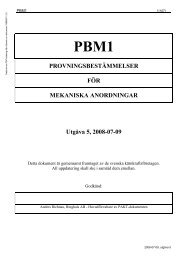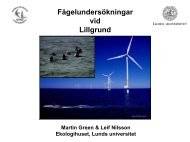Birds in southern Öresund in relation to the wind farm at ... - Vattenfall
Birds in southern Öresund in relation to the wind farm at ... - Vattenfall
Birds in southern Öresund in relation to the wind farm at ... - Vattenfall
Create successful ePaper yourself
Turn your PDF publications into a flip-book with our unique Google optimized e-Paper software.
Long-tailed Duck Clangula hyemalis<br />
.<br />
The Long-tailed Duck was regularly seen dur<strong>in</strong>g <strong>the</strong> surveys <strong>in</strong> <strong>the</strong> study area but <strong>the</strong> numbers<br />
counted were generally rel<strong>at</strong>ively low (Fig. 14 & 15). The majority of <strong>the</strong> Long-tailed Ducks<br />
were counted <strong>in</strong> <strong>the</strong> reference area south of Falsterbo, whereas only smaller numbers occurred<br />
<strong>in</strong> <strong>Öresund</strong>. In <strong>the</strong> <strong>sou<strong>the</strong>rn</strong> area more than 1000 <strong>in</strong>dividuals were sometimes counted <strong>in</strong> <strong>the</strong><br />
survey belt, whereas maximum counts from <strong>the</strong> nor<strong>the</strong>rn parts were around 100, up <strong>to</strong> 200<br />
and a little more be<strong>in</strong>g maximum counts from <strong>the</strong> bo<strong>at</strong> surveys.<br />
Long-tailed Ducks were regularly seen <strong>at</strong> Lillgrund before <strong>the</strong> construction of <strong>the</strong> w<strong>in</strong>d <strong>farm</strong>,<br />
larger numbers be<strong>in</strong>g seen <strong>at</strong> <strong>the</strong> bo<strong>at</strong> counts than dur<strong>in</strong>g aerial surveys (Fig. 16 & 17). In <strong>the</strong><br />
post-construction years only few Long-tailed Ducks were counted <strong>in</strong> <strong>the</strong> w<strong>in</strong>d <strong>farm</strong> area and<br />
<strong>the</strong> density was much lower <strong>in</strong> both <strong>the</strong> w<strong>in</strong>d <strong>farm</strong> area and <strong>in</strong> <strong>the</strong> 2 km buffer zone (Fig. 18).<br />
Numbers counted <strong>in</strong> <strong>the</strong> different zones (used for <strong>the</strong> density calcul<strong>at</strong>ions) was generally low.<br />
In <strong>the</strong> w<strong>in</strong>d<strong>farm</strong> area a mean count of two <strong>in</strong>dividuals was obta<strong>in</strong>ed for <strong>the</strong> three surveys <strong>in</strong><br />
2006, whereas only one Long-tailed Duck was seen dur<strong>in</strong>g n<strong>in</strong>e censuses post-construction.<br />
Total number of Long-tailed Ducks counted with<strong>in</strong> <strong>the</strong> buffer zone varied between four and<br />
seven, whereas between 32 and 77 were counted <strong>at</strong> aerial surveys <strong>in</strong> <strong>the</strong> outer area. For fur<strong>the</strong>r<br />
details see Table A10 <strong>in</strong> <strong>the</strong> appendix. Spr<strong>in</strong>g numbers were <strong>to</strong>o low <strong>to</strong> calcul<strong>at</strong>ed densities<br />
for this species.<br />
The same p<strong>at</strong>tern emerges when we look <strong>at</strong> <strong>the</strong> Jacob’s <strong>in</strong>dices <strong>in</strong> Table 4. Dur<strong>in</strong>g <strong>the</strong> bo<strong>at</strong><br />
surveys a certa<strong>in</strong> amount of preference was recorded for <strong>the</strong> w<strong>in</strong>d <strong>farm</strong> area dur<strong>in</strong>g <strong>the</strong> preconstruction<br />
period (D = 0.48), which changed <strong>to</strong> a weak avoidance for <strong>the</strong> post-construction<br />
years (D = -0.14). The direction of <strong>the</strong> change was similar based on d<strong>at</strong>a from <strong>the</strong> aerial<br />
surveys although Jacob’s <strong>in</strong>dex <strong>in</strong>dic<strong>at</strong>ed a weak avoidance already before <strong>the</strong> construction of<br />
<strong>the</strong> w<strong>in</strong>d <strong>farm</strong> (D = -0.23). Post construction a much stronger avoidance was <strong>in</strong>dic<strong>at</strong>ed (D =<br />
-0.85). Based on d<strong>at</strong>a from <strong>the</strong> buffer zone, up <strong>to</strong> 2 km from <strong>the</strong> w<strong>in</strong>d <strong>farm</strong>, <strong>the</strong> two survey<br />
methods yielded different overall results. While <strong>the</strong> bo<strong>at</strong> surveys showed preference for <strong>the</strong>se<br />
parts both before after construction of <strong>the</strong> w<strong>in</strong>d <strong>farm</strong> (D = 0.78 and 0.77 respectively), <strong>the</strong><br />
aerial surveys showed th<strong>at</strong> <strong>the</strong> buffer zone was used as expected dur<strong>in</strong>g <strong>the</strong> pre-construction<br />
period but less than expected (avoided) with <strong>the</strong> w<strong>in</strong>d <strong>farm</strong> <strong>in</strong> oper<strong>at</strong>ion (D = 0.06 and -0.41<br />
respectively).<br />
35


